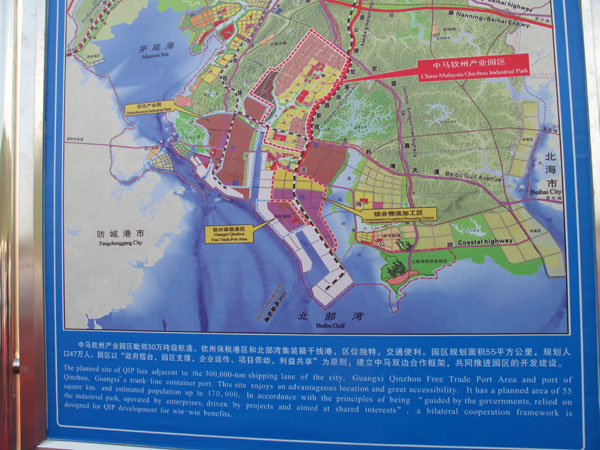Sizeable projects boost Beibu Gulf economy
Updated: 2011-10-25 20:38
By Rong Xiandong (chinadaily.com.cn)
|
|||||||||||
South China's Guangxi Zhuang autonomous region is aiming high to accelerate the development of the Beibu Gulf Economic Zone and boost its economic and trade ties with ASEAN countries.
 |
|
A map showing the China-Malaysia industrial park. [By Rong Xiandong/chinadaily.com.cn] |
The Beibu Gulf Economic Zone, a part of the nation's key development strategy, principally includes the capital city of Nanning and three port cities: Qinzhou, Fangchenggang and Beihai
Major projects have played an important role in the development of Guangxi's local economy and regional cooperation since the free trade area was established between China and ASEAN in 2010.
The Qinzhou free trade port area, the sixth of its kind in China, achieved an output value of 10 billion yuan ($1.57 billion) eight months after starting operations in February this year.
"The remarkable achievement of the Qinzhou area is an important milestone in the development of the Beibu Gulf Economic Zone that will greatly promote the development of the China-ASEAN free trade area," said Gao Xiong, Vice-Governor of Guangxi, while attending the China-ASEAN Expo in Nanning.
Gao said Guangxi is trying to build the Qinzhou free trade port area into a regional shipping hub, logistics center and processing center aimed at boosting China-ASEAN cooperation.
The free trade port has a total area of 10 square kilometers and 2.5 square kilometers in its first phase, for which most of the projects have been finalized.
China's State Council has approved the area as the country's fifth auto import and export port.
The Qinzhou free trade port's import and export volume was nearly $400 million from January to Sept this year, according to Wang Naixue, Director of the free trade port administration committee, which is directly managed by the Guangxi regional government.
China and Malaysia, China's largest trading partner in ASEAN, have signed an agreement to build a China-Malaysia industrial park. Malaysia is the third country to jointly develop industrial parks with China after Singapore and South Korea.
A number of Chinese companies attending the China-ASEAN Expo have expressed their willingness to enter the park, according to Zhang Xiaoqin, Qinzhou's Party secretary.
The park has a planned area of about 55 square kilometers and a planned population of 470,000, compared to the city's current population of 3.88 million.
It will focus on developing manufacturing, including auto and ship parts, information technology industry including electronic information and cloud computer data centers, and modern services including finance and education.
"The park will also be used as a platform to boost Chinese investment in Malaysia and a China-Malaysia industrial park might be built in Malaysia in the future to promote bilateral trade and investment," said Zhang.
Hot Topics
New sex education textbooks were introduced to pupils in Shanghai on Monday after numerous debates on early-age sex education in China.
Editor's Picks

|

|

|

|

|

|







